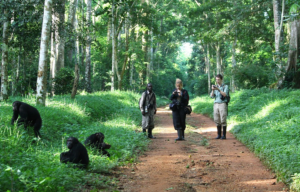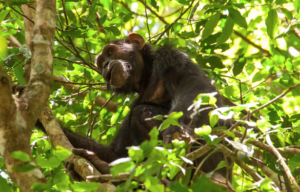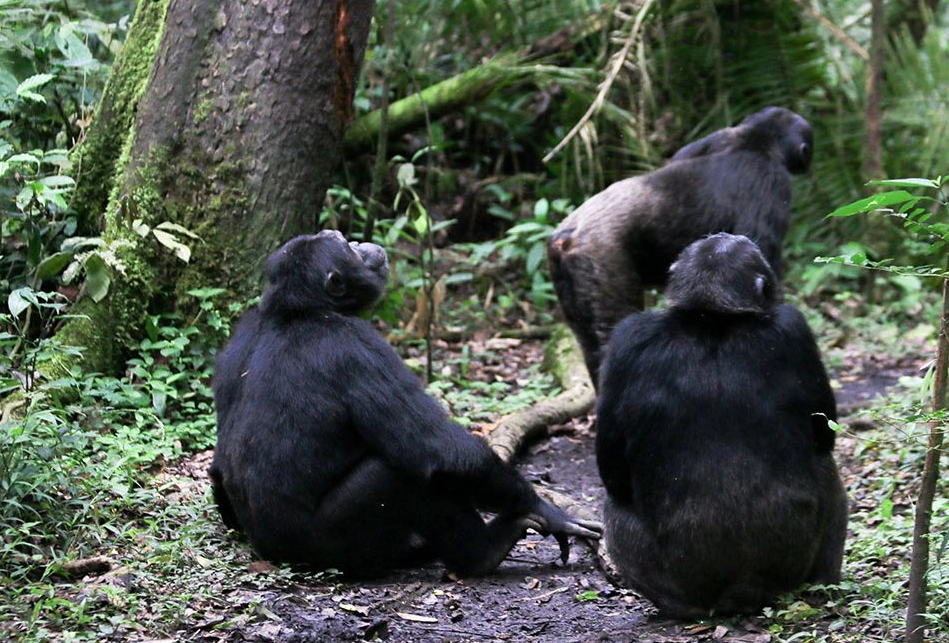Chimpanzee Interesting Facts | Chimpanzee Trekking
Chimpanzee Interesting Facts | Chimpanzee Trekking
Chimpanzee Interesting Facts | Chimpanzee Trekking : is a specie of great ape native to the forests and savannahs of tropical Africa. As a matter of fact, in the whole world there are four confirmed subspecies. In fact, the chimpanzee and the closely related bonobo (pygmy chimpanzee) are classified in the genus Pan. The Eastern chimpanzee (Pt. shweinfurthii) is a subspecies that occurs in different countries. These include; Uganda, Rwanda, Tanzania, Burundi, South Sudan, DRC and Central African Republic.
Chimpanzee Trekking in Uganda
 This activity generally allows you to step into the jungle in search of these great apes. During this activity, you are given a maximum of one hour in their presence standing from a safe distance of 7m. While here, you are allowed to enjoy their daily activities as well as take photos and videos for remembrance. Besides chimpanzee trekking, we have also got chimpanzee habituation that can be enjoyed while in Uganda. Basically in Uganda we have 3 major chimp trekking destinations. These include; Kibale National Park, Queen Elizabeth National Park in Kyambura Gorge and Murchison Falls National Park in Budongo forest. However, Kibale has the highest population and the best views of these endangered primates. Therefore, ranked as the best destination in Uganda for chimpanzee trekking.
This activity generally allows you to step into the jungle in search of these great apes. During this activity, you are given a maximum of one hour in their presence standing from a safe distance of 7m. While here, you are allowed to enjoy their daily activities as well as take photos and videos for remembrance. Besides chimpanzee trekking, we have also got chimpanzee habituation that can be enjoyed while in Uganda. Basically in Uganda we have 3 major chimp trekking destinations. These include; Kibale National Park, Queen Elizabeth National Park in Kyambura Gorge and Murchison Falls National Park in Budongo forest. However, Kibale has the highest population and the best views of these endangered primates. Therefore, ranked as the best destination in Uganda for chimpanzee trekking.
Chimpanzee Subspecies
The four subspecies of the common chimpanzee that have been recognized and these include;
- Central chimpanzee; found in Cameroon, Central African Republic, Equatorial Guinea, Gabon and DRC.
- Western chimpanzee; found in Guinea-Bissau, Mali, Senegal, Sierra Leone, Liberia, Ivory Coast and Ghana.
- Eastern chimpanzee; in Central African Republic, South Sudan, DRC, Uganda, Rwanda, Burundi, Tanzania and Zambia
- Nigeria-Cameroon chimpanzee; found in Nigeria and Cameroon.
- Southeastern chimpanzee; found in Burundi, Rwanda, Tanzania and Uganda.
Chimpanzee Facts
Appearance and physiology
A chimpanzee adult male weigh between 40–60 kg with females weighing between 27–50 kg. In addition, the arms of a chimp are longer than its legs, and can reach below the knees. The hands have long fingers with short thumbs and flat fingernails whereas the feet are adapted for grasping. It has forward-facing eyes, a small nose, rounded non-lobed ears and a long mobile upper lip. Chimpanzee bodies are covered by coarse hair, except for the face, fingers, toes, palms of the hands, and soles of the feet. They also lose more hair as they age, and develop bald spots. On the other hand, the hair of a chimp is typically black but can be brown. As they get older, white or grey patches may appear, particularly on the chin and lower region.
Ecology
The common chimpanzee is particularly a highly adaptable species. It lives in a variety of habitats, including dry savanna evergreen rainforest, swamp forest and dry woodland savanna mosaic. Besides, chimpanzee makes a night nest in a tree in a new location every night. Here, every chimpanzee in a sleeps in separate nest other than infants or juvenile chimpanzees, which sleep with their mothers.
Hunting
Chimpanzees generally hunt where the forest canopy is interrupted or irregular. In fact, this allows them to easily corner the monkeys when chasing them in the appropriate direction. Chimps may also hunt as a coordinated team so that they can corner their prey even in a continuous canopy. However, male chimps hunt more than females. When caught and killed, the meal is distributed to all hunting party members and even bystanders.
Diet
To begin with, a chimpanzee is an omnivorous animal but prefers fruit above all other food items. Other foods include; leaves, leaf buds, seeds, blossoms, stems, pith not to mention but a few. While the common chimpanzee is mostly herbivorous, it does eat honey, soil, insects, birds and their eggs, and small to medium-sized mammals, including other primates. However, the majority of their diet consists of fruits, leaves, roots, and other plant matter. Female chimpanzees appear to consume much less animal flesh than males, according to several studies.
Mating and parenting
These primates mate throughout the year and adulthood males can have their first child around 15yrs. However, the females have their first child between 13 and 14 years old. Meanwhile, the number of females in oestrus varies seasonally in a group. During oestrus, females mate with several males in their community. A community’s dominant male sometimes restrict reproductive access to females. Here, females sometimes leave their community and mate with males from neighboring communities. In addition, chimpanzees have a gestation period of eight months and care for the young is mostly provided by their mothers.
 Interestingly, their first 30 days, infants cling to their mother’s bellies. Mothers provide their young with food, warmth, protection and teach them certain skills. A baby chimpanzee is born with a cute pink face and white hair on their backside that disappears with age. However, baby chimps are helpless whereby their grasping reflex is not strong enough to support them for more than a few seconds. When they reach five to six months, infants ride on their mothers’ backs and remain in continual contact for the rest of their first year. Adolescent females move between groups and are supported by their mothers in agonistic encounters. However, adolescent males spend time with adult males in social activities like hunting and boundary patrolling.
Interestingly, their first 30 days, infants cling to their mother’s bellies. Mothers provide their young with food, warmth, protection and teach them certain skills. A baby chimpanzee is born with a cute pink face and white hair on their backside that disappears with age. However, baby chimps are helpless whereby their grasping reflex is not strong enough to support them for more than a few seconds. When they reach five to six months, infants ride on their mothers’ backs and remain in continual contact for the rest of their first year. Adolescent females move between groups and are supported by their mothers in agonistic encounters. However, adolescent males spend time with adult males in social activities like hunting and boundary patrolling.
Mortality
The average lifespan of a chimpanzee is usually less than 15 years. Captive chimps live longer with median lifespans of 31.7 years for males and 38.7 years for females. Leopards are recorded to have preyed on chimpanzees in some areas though chimps may react to a leopard’s presence. This is done through loud vocalizing, branch shaking and throwing objects.
Tool use
Actually all chimpanzee populations have been recorded using tools whereby they modify sticks, rocks, grass, and leaves. In this situation they use them when foraging for honey, termites, ants, nuts and water. Due to lack of complexity, fore thought and skill are apparent in making these tools. Chimps also use leaves as sponges or spoons to drink water.
Group structure
They live in communities that typically range from 20-150 members. However, spend most of their time travelling in small groups consisting of a few individuals. These may consist of any combination of age and sex classes but males and females sometimes travel alone. At the core of social structures are males which roam around, protect group members and search for food.
Besides males remain in their natal communities while females generally emigrate at adolescence. Males in a community are more likely to be related to one another than females are to each other. Low-ranking males commonly switch sides in disputes between more dominant individuals. They also benefit from an unstable hierarchy and have increased sexual opportunities. In addition, conflicts between dominant males cause them to focus on each rather than the lower-ranking males.
Communication
These endangered primates generally use facial expressions, postures and sounds to communicate with each other. Chimps also have expressive faces which are important in close-up communications. When frightened, a “full closed grin” causes nearby individuals to be fearful as well. They may also express themselves with the “pout” which is made in distress. The “sneer” which is made when threatening or fearful and “compressed-lips face” which is a type of display. While travelling, chimps keep in contact by beating their hands and feet. They beat them against the trunks of large trees, an act known as “drumming”. They also do this when encountering individuals from other communities.
Frequently asked questions
How long do chimpanzees live?
Generally the chimpanzee’s lifespan in the wild is around 38 to 40 years. In captivity a female chimpanzee can live up to 39 years while the male lives up to 32 years old.
What do chimpanzees eat?
As a matter of fact, chimpanzees are omnivorous, but eat fruit more than anything else. Most of a chimpanzee’s diet comes from our bits of plants (seeds, leaves, roots, resin etc). However, will also eat insects, honey, birds and bird eggs, mammals and even soil.
Where do chimpanzees live?
As a highly adaptable species, chimpanzees inhabit a range of habitats. These include; tropical rainforest, montane rainforests, less densely vegetated forest-savannah mosaics and even dry savannah.
Where can you find chimpanzees in Uganda?
In Uganda you can track chimpanzees in Kibale, Queen in Kyambura Gorge and Murchison Falls in Budongo forest. How We also have chimps in Ngamba Island Sanctuary which is a home of orphaned chimpanzees.
How strong are chimps?
These animals are enormously strong estimated to be around four times stronger than a human of a similar size. They can also reach speeds of 25mph (40kph) when running. In addition, thier arms are designed to swing them through the trees. They also have a much higher proportion of fast-twitch muscle fibers, which seems to be what gives them their extraordinary strength.
Do chimpanzees live in groups?
At least chimpanzees live in groups which range in size from 15-150 members. They live in fission-fusion societies meaning that the size and composition of their social groups changes over time. These animals also spend the majority of their time in small temporary groups. They also spend it with just a few individuals known as ‘parties’ but also associate with a wider group known as a ‘community’.
Can chimpanzees use tools?
These are basically one of the few animals that are known to use tools. These includes the use of sticks to retrieve termites from their mounds. Stones to open up appetizing nut contents and leaf-sponges to soak up drinking water.
Can chimpanzees communicate?
Basically chimpanzees make around 30 different vocalizations. The most common and loudest is the pant-hoot, a long-distance call. It is used for a variety of social reasons but particularly for keeping in touch with fellow troop members.
When do chimps reproduce?
The chimp has generally got a gestation period of eight months. The infant is weaned at about three years old and usually maintains a close relationship with its mother. Females will reach reproductive maturity by age 13 and can give birth at any time of the year. Chimpanzees exhibit large pink sexual swellings on their behinds which advertise their fertility to prospective mates. They usually give birth to just one infant. infants will cling tightly to its mother’s fur for their first 30 days, and then take rides on her back until two years of age.
Can chimps walk on two legs?
Surprisingly, chimps get around by climbing and swinging through trees. They also walk on all fours (knuckle-walking) but they can also walk upright on two feet if they want to.
How clever are chimpanzees?
By using tools, some chimpanzees have even been able to learn basic human sign language.








Leave a Reply
Want to join the discussion?Feel free to contribute!